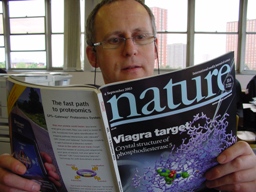 In March, over 120 ‘gibberish’ conference abstracts (published by Springer and the US-based Institution of Electrical and Electronic Engineers*) were withdrawn after researcher Cyril Labbé (Joseph Fourier University) identified them as computer-generated fakes.
In March, over 120 ‘gibberish’ conference abstracts (published by Springer and the US-based Institution of Electrical and Electronic Engineers*) were withdrawn after researcher Cyril Labbé (Joseph Fourier University) identified them as computer-generated fakes.
Labbé was the man to do it, because he created ‘SCIgen’, a web-based science bullshit generator, capable of writing scientific gobbledegook indistinguishable (to the non-specialist) from the writing of human scientists. His motive in creating SCIgen was to expose poor peer reviewing; but since releasing it to the wild, he has had to develop a bloodhound program to sniff out its products.
Scientists may not fear for their jobs just yet; but spare a thought for journalists and PROs. After March’s ‘gibberish’ scandal a Swedish study appeared, revealing that computer-generated news content could offer cost-conscious proprietors (that’s all of them) a way to write newspapers without journalists. (It has begun. The LA Times already uses an algorithm called ‘Quakebot’ to report tremors, and on 17 March its first product appeared online just three minutes after the temblor hit.)
Tests conducted by Christer Clerwall (Karlstad University) exposed media studies students to two sports reports - one written by computer, one by a journalist. The anthropogenic story was rated higher for ‘readability’, while the android story was considered ‘boring’; but the differences between other ratings (coherence, usefulness, informativeness, accuracy, trustworthiness, objectivity) , were statistically insignificant (and not always in the human’s favour). Most students guessed correctly which story was which; but a surprisingly large minority got it wrong.
Similar algorithms already exist for converting scientific papers into news releases. The results are not great, but they are not the worst examples I have ever seen of this highly technical genre (though that isn’t saying very much).
So it is not surely too fanciful to foresee a time when computer-devised experiments can produce results easily assimilable into the formulaic literary genre of the scientific paper. An equally formulaic abstract can then be pinged to conference organisers for inclusion. Media applications can then generate formulaic news releases, hot-linked to the original paper, which can be sent under embargo to accredited robot ‘journalists’. These will then write formulaic news stories, complete with punny headlines and grabby standfirsts (because by then I shall have patented an application of my own which I plan to call ‘GROANfactor’).
Thus, the whole process of science and its communication may soon be completely outsourced, leaving human beings free to engage in more rewarding pursuits – like contemplating the pointlessness of existence and moaning about it to each other on Facebook.
TED NIELD
Editor
@TedNield
@geoscientistmag
*Please note - the print version of this story wrongly credited the UK-based Institution of Electrical Engineers with this dubious honour, for which we offer our apologies. Editor.